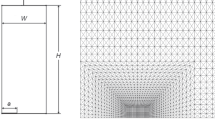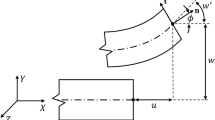Abstract
This paper deals with a procedure to calculate the elastic stress intensity factors for arbitrary-shaped cracks in plane stress and plane strain problems. An assumed displacement hybrid finite element model is employed wherein the unknowns in the final algebraic system of equations are the nodal displacements and the elastic stress intensity factors. Special elements, which contain proper singular displacement and stress fields, are used in a fixed region near the crack tip; and the interelement displacement compatibility is satisfied through the use of a Lagrangean multiplier technique. Numerical examples presented include: central as well as edge cracks in tension plates and a quarter-circular crack in a tension plate. Excellent correlations were obtained with available solutions in all the cases. A discussion on the convergence of the present solution is also included.
Résumé
Le mémoire a trait à une procédure pour le calcul des facteurs d'intensité des contraintes élastiques dans le cas de fissures de formes arbitraires soumises à état plan de tension ou de déformation. Un modèle de déplacements hypothétiques à éléments finis hybrides est utilisé, dans lequel les inconnues dans le système final d'équations algébriques sont les déplacements nodaux et les facteurs d'intensité des contraintes. Des éléments spéciaux, comportant leurs propres déplacements et champs de contraintes singuliers, sont utilisés dans une région déterminée voisine de l'extrémité de la fissure; la compatibilité de déplacement entre les éléments est satisfaite en recourant à la technique de multiplication d'un Lagrangien. Des exemples numériques sont présentés, notamment: fissures centrales ou de bord dans des tôles soumises à tension, fissure en quart de cercle dans une tôle tendue. D'excellentes corrélations ont été établies avec les solutions disponibles pour chaque cas traité. On procède également à une discussion sur la convergence de la solution proposée.
Zusammenfassung
Dieser Bericht behandelt ein Verfahren zur Rechnung der elastischen Spannungsintensitatsfaktoren von Rissen beliebiger Form in ebenen Spannungs- und ebenen Verformungsproblemen. Man benützt ein festgelegtes Verschiebungsmodell hybrider endlicher Elementen indem die Unbekannten im Endgleichungssystem die Knotenverschiebungen und die elastischen Spannungsintensitätsfaktoren sind. Besondere Elemente, die eigene singuläre Verschiebungen und Spannungsfelder enthalten, werden in einem festgelegten Gebiet an der Rißspitze benützt, und die Komptabilität der Verschiebungen zwischen Elementen werden durch ein Multiplikationsverfahren von Lagrange erfüllt. Die angegebene Rechenbeispiele enthalten: Mittel- sowohl als Randrisse in Platten unter Zugspannung, und ein Viertelkreisriß in einer Platte unter Zugspannung. Ausgezeichnete Korrelation ergab sich mit allen zur Verfügung stehenden Lösungen in allen Fällen. Die Konvergenz der angegebenen Lösung wird auch besprochen.
Similar content being viewed by others
References
J. R. Rice, Mathematical Analysis in the Mechanics of Fracture, Fracture, Vol. II, (Edited by H. Liebowitz) Academic Press (1968) 192–308.
A. S. Kobayashi, D. E. Maiden, B. J. Simon and S. Iida, Application of the Method of Finite Element Analysis to Two-Dimensional Problems in Fracture Mechanics, University of Washington, Department of Mechanical Engineering Report, October (1968).
J. K. Chan, I. S. Tuba and W. K. Wilson, Journal of Engineering Fracture Mechanics, 2 (1970) 1–17.
V. B. Watwood, The Finite Element Method for Prediction of Crack Behavior, Nuclear Engineering and Design, Vol. II (1969) 323–332.
G. P. Anderson, V. L. Ruggles and G. S. Stikor, International Journal of Fracture Mechanics, 7, 1 (1971) 63–76.
P. D. Hilton and G. C. Sih, Applications of the Finite Element Method to the Calculations of Stress Intensity Factors, Methods of Analysis of Crack Problems (Edited by G. C. Sih), Noordhoff International Publishing, Leyden (1973).
P. Tong and T. H. H. Pian, International Journal of Solids and Structures, (1973) 313–321.
E. Byskov, International Journal of Fracture Mechanics, 6, 2, (1970), 159–167.
D. M. Tracey, International Journal of Fracture Mechanics, 3, 3 (1971) 255–266.
P. Tong and T. H. H. Pian, International Journal of Solids and Structures, 3 865–879.
N. J. Levy and P. V. Marcal, Three-Dimensional Elastic Plastic Stress Analysis for Fracture Mechanics, Heavy Section Steel Technology Program, Fifth Annual Meeting, Paper No. 11, Oak Ridge National Laboratories, March (1971).
T. H. H. Pian, P. Tong and C. H. Luk, Elastic Crack Analysis by a Finite Element Hybrid Method, Proceedings of the Third International Conference on Matrix Methods in Structural Mechanics, Wright-Patterson Air Force Base, Ohio, November (1971).
T. H. H. Pian, Element Stiffness Matrices for Boundary Compatibility and for Prescribed Boundary Stresses, Proceedings of the First Conference of Matrix Methods in Structural Mechanics, AFFDL-TR-66-80 (1967) 457–477.
P. Tong, T. H. H. Pian and S. Lasry, A Hybrid-Element Approach to Crack Problems in Plane Elasticity, to appear in the International Journal of Numerical Methods in Engineering.
O. L. Bowie, and D. M. Neal, International Journal of Fracture Mechanics, 6 (1970) 299–306.
O. L. Bowie, and D. M. Neal, Engineering Fracture Mechanics, 2 (1970) 181–182.
O. L. Bowie, C. E. Freese and D. M. Neal, Solution of Plane Problems of Elasticity Utilizing Partitioning Concepts, ASME paper 73-APM-C.
J. A. H. Hult and F. A. McClintock, Elastic-Plastic Stress and Strain Distribution around Sharp Notches under Repeated Shear, IXth International Congress of Applied Mechanics, University of Brussels, 8 (1957) 51–58.
M. F. Koskinen, Journal of Basic Engineering, Trans. ASME, 86, Series D (1963) 585–588.
J. R. Rice and G. F. Rosengren, Journal of Mechanics and Physics of Solids, 16 (1968) 1–12.
J. W. Hutchinson, Journal of Mechanics and Physics of Solids, 16 (1968) 13–31.
J. W. Hutchinson, Journal of Mechanics and Physics of Solids, 16 (1968) 337–347.
P. Tong, International Journal of Numerical Methods in Engineering, 2 (1960) 78–83.
S. Atluri and T. H. H. Pian, Journal of Structures and Mechanics, 1 (1972) 1–43.
S. Atluri, A. S. Kobayashi and M. Nakagaki, Application of an Assumed Displacement Hybrid Finite Element Procedure to Two-Dimensional Problems in Fracture Mechanics, submitted for presentation and publication at The 15th Structures, Structural Dynamics and Materials Conference, April 17–19, (1974) Las Vegas.
B. Gross and J. E. Strawley, Stress Intensity Factor for a Single-Edge-Notch Tension Specimen by Boundary Collocation of a Stress Function, NASA TN D-2398, August (1964).
G. C. Sih, P. C. Paris, and F. Erdogan, Journal of Applied Mechanics, Trans. of ASME, 29 (1962) 306–312.
M. A. Hussain and S. L. Pu, Journal of Applied Mechanics, 38 (1971) 627–633.
O. C. Zienkiewicz, The Finite Element Method in Engineering Science, McGraw-Hill, New York (1971).
Author information
Authors and Affiliations
Additional information
This work was supported by the U.S. Air Force Office of Scientific Research, Grant AFOSR-73-2478.
Rights and permissions
About this article
Cite this article
Atluri, S.N., Kobayashi, A.S. & Nakagaki, M. An assumed displacement hybrid finite element model for linear fracture mechanics. Int J Fract 11, 257–271 (1975). https://doi.org/10.1007/BF00038893
Received:
Revised:
Issue Date:
DOI: https://doi.org/10.1007/BF00038893




